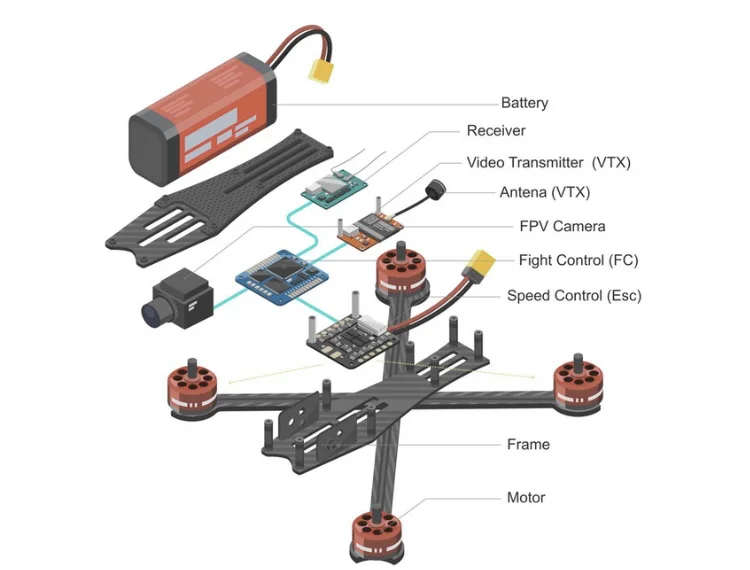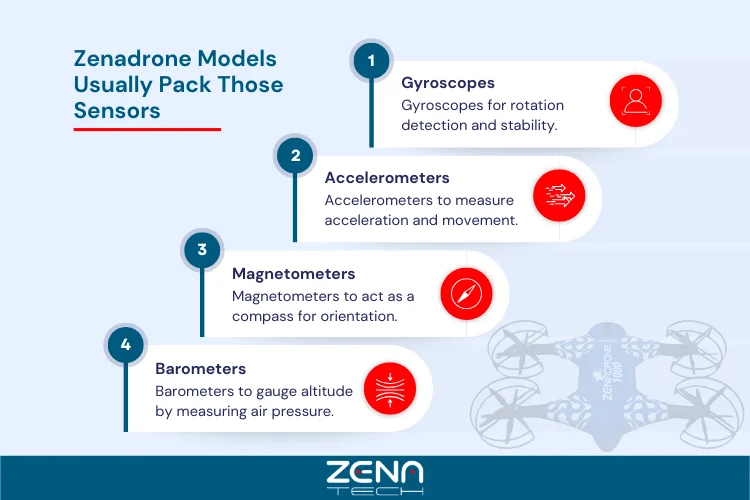Drones have several key components that work together for smooth flight. Knowing these parts helps users with maintenance, repairs, and upgrades. Understanding each component’s role makes troubleshooting and improving performance way easier.
Let’s dive into how these parts interact to improve drone control, efficiency, and longevity. Both beginners and experienced pilots benefit from learning how each component enhances overall performance. This knowledge is also key for making informed, cost-effective upgrades.
In this article we will discover the 7 essential drone parts for smoother flying.
Why are Drone parts important?
Understanding how each part works helps users to enhance UAV efficiency. Drone accessories are crucial in efficient use whether for recreational or professional flights. Every part of a drone is a vital piece that contributes to overall performance, stability and functionality.
Professional drone users know the importance of maintenance of every part of their equipment. It’s important for beginners to know how each part of the drone needs maintenance to ensure longevity.
The Parts of a Drone
Here’s a quick list of drone parts featured in the infographic.

Frame
The frame is the backbone of any drone. The frame is the drone’s body since it provides structural integrity. The frame houses the motors, controllers and batteries. The right frame is important for performance especially for racing and professional photography drones.
Motors
The best UAV motors are sometimes expensive. Drone motors are strong and effective. Drones need enough thrust power to lift off the ground. Each drone motor controls a propeller and affects flight stability and maneuverability. Strong drone motors increases payload capacity, speed and acceleration.
The type of drone depends on how many motors it has. For example, quadcopters have 4 motors while hexacopters have 6 motors for more stability. Selecting the right motor reduces overheating and extends flight. Proper motor maintenance ensures drone performance and long term reliability.
Students who are learning the engineering principles behind drone mechanics often find concepts like thrust and torque challenging to grasp, especially when trying to connect theory to real-world flight performance. Getting a bit of engineering homework help can make these ideas clearer and easier to apply during hands-on work. With a better understanding of these fundamentals, student drone enthusiasts can troubleshoot more confidently and make smarter choices when upgrading or fine-tuning their equipment.
Propellers
Speed, stability, and efficiency are all impacted by a drone’s size, shape, and pitch. In order to permit flight, drone propellers push air downward to create lift. Though they decrease maneuverability, larger propellers provide more thrust. Although they may require greater motor speeds, smaller propellers provide agility.
Two-blade propellers maximize speed and efficiency, while three or four-blade designs improve stability and control in windy conditions. Propeller material, such as plastic or carbon fiber, impacts durability, weight, and vibration levels during flight.
Balanced propellers reduce vibrations, enhancing flight smoothness and camera stability for aerial photography or videography. Damaged or unbalanced propellers decrease performance, causing instability. Regular inspection and replacement ensure safe and efficient flights.
Flight Controller
One of the integral drone parts is the flight controller, which acts as the “brain” of any drone. The controller adjusts motor speeds based on gyroscope and accelerometer readings, ensuring balance and smooth movements in different flight conditions.
Advanced flight controllers feature GPS for precise navigation, enabling autonomous modes like waypoint tracking and return-to-home. Some controllers support obstacle avoidance, using sensors to detect and avoid collisions for safer flying in complex environments.
Pilots can customize flight controller settings to optimize responsiveness, stability, and flight performance for racing, photography, or industrial applications.
Battery and Power System
The drone motor runs on a battery and a power system. The battery supplies power to all drone components, affecting flight time, performance, and overall efficiency. In short, the power system keeps the UAV airborne.
Lithium-polymer (LiPo) batteries are commonly used due to their lightweight design, high energy density, and quick discharge rates. Battery capacity, measured in milliamp-hours (mAh), determines how long a drone can stay airborne before recharging.
Higher voltage (V) batteries provide more power, improving performance but requiring compatible electronic speed controllers and motors. The discharge rate (C-rating) affects how quickly a battery delivers power, influencing acceleration and responsiveness. Proper battery maintenance, including balanced charging and safe storage, extends lifespan and prevents overheating or damage.
Sensors and Navigation Systems
Sensors collect real-time data, helping the drone maintain stability, avoid obstacles, and navigate accurately. One of the renowned sensors in drones is the GPS.
A GPS drone has an accurate positioning, supporting autonomous flight modes like waypoint navigation and return-to-home. Obstacle avoidance sensors use infrared, ultrasonic, or LiDAR technology to detect and prevent collisions.
Here are a few examples of sensors and navigation systems in drones:
-
- Gyroscopes: detect angular movement, ensuring balance and smooth flight corrections during maneuvers.
-
- Accelerometers: measure linear motion, helping stabilize the drone during sudden speed changes or turbulence.
-
- Magnetometers: assist with navigation by detecting the Earth’s magnetic field, improving directional accuracy.
-
- Barometers: estimate altitude by detecting air pressure, enabling precise height control and smoother landings.
Remote Controller
Drone accessories also include a controller, which the pilot uses to control the drone from afar. The remote controller sends pilot inputs to the drone, enabling precise flight control and maneuverability.
The remote control in the drone part utilizes radio frequency (RF) signals to communicate with the drone, ensuring real-time responsiveness. Controllers feature joysticks for movement, adjusting altitude, direction, and speed with precision. Controllers include LCD screens or smartphone integration for live telemetry and video feeds.
Advanced models support customizable buttons, improving accessibility for flight modes and camera controls. Longer transmission ranges allow extended flights, depending on signal strength and interference levels. Ergonomic designs enhance comfort, reducing pilot fatigue during extended drone operations.
Types of Drones: A Concise Summary of Different Models
Drone parts vary in design, features, and purpose, which cater to various industries and user needs.
Here is a list of examples of sensors usually found in drones:
-
- Quadcopters have four rotors, offering stability, easy control, and versatility for photography, racing, and recreational flying.
-
- Hexacopters use six rotors, providing better lift, redundancy, and stability, ideal for industrial applications and heavy payloads.
-
- Octocopters feature eight rotors, enhancing power, stability, and safety for professional cinematography and large-scale surveying.
-
- Fixed-wing drones resemble airplanes, offering longer flight times and higher speeds, making them suitable for mapping and agriculture.
-
- FPV (First-Person View) drones provide immersive piloting experiences and are commonly used for racing and freestyle flying.
-
- Autonomous drones use AI and GPS for automated missions, including delivery, surveillance, and scientific research.
Conclusion
Each drone part is crucial in-flight control, maneuverability, and safety. Awareness of how UAV components work improve performance, stability, and efficiency for better flying experiences. Regular maintenance and upgrades enhance durability, responsiveness, and overall functionality.
Choosing the right drone and components ensures better photography, racing, or industrial applications results. A well-maintained drone provides smoother flights, a longer lifespan, and fewer technical issues. Mastering drone components helps pilots troubleshoot problems, improve handling, and maximize flight potential.

